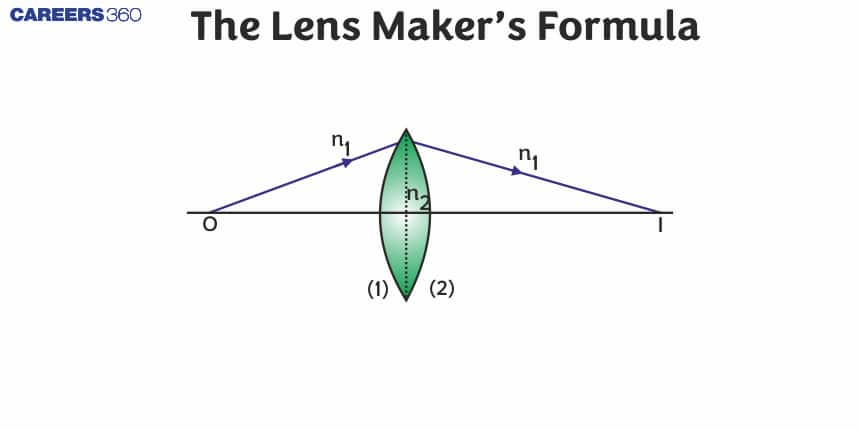The Lens Maker’s Formula - Definition, Solved Examples, FAQs
In this article, we will discuss about, what is lens maker’s formula? What is radius of curvature of lens? What is lens maker formula for concave lens? What is lens maker equation? What is relation between focal length and refractive index? What is curvature of lens? So let’s see,
What is lens maker’s formula?
Lens is a refracting object (device), which include of a transparent material. It can have 2 curved s/f (surfaces) or 1 curved and 1 plane s/f (surface). Basically, lenses can be categorized or classified as convex (converging) and concave lenses (diverging).
Definition: Real lenses have the limited thickness between their two exterior/surfaces of curvature. An ideal thin lens with two surfaces of uniform curvature will have zero refracting (optical) power. It means it wills neither convex nor concave light. A lens with some thickness which is not trivial is called a thick lens.
JEE Main/NEET 2027: Physics Important Formulas for Class 10
NEET 2025: Mock Test Series | Syllabus | High Scoring Topics | PYQs
JEE Main: Study Materials | High Scoring Topics | Preparation Guide
JEE Main: Syllabus | Sample Papers | Mock Tests | PYQs

The focal length of a lens depends on the index of refraction (refractive index) of the lens and the radii of curvature. The lens maker’s equation is second formula used for lenses that provide us a relationship betwixt the focal distance (length), index of refraction, and radii of curvature of the two spheres used in lenses. It is employed by lens manufacturers to form the lenses of particular power from the glass of a given index of refraction.
Lenses are of two kinds based on the curvature of the two refracting surfaces. Convex and concave.
Also read -
- NCERT Solutions for Class 11 Physics
- NCERT Solutions for Class 12 Physics
- NCERT Solutions for All Subjects
What is lens maker’s Equation?
Lens maker’s Equation/formula for thin lens:
Lens maker formula is used to assemble a lens with the itemize focal length. A lens has 2 curved surfaces, but these are not exactly the selfsame. If we know the index of refraction and the radius of the curvature of both the surface, then we can find out the focal length of the lens by using the given lens maker’s formula:
1/f=(μ-1)×(1/R1 - 1/R2)
Where,
f=focal length of the lens
μ= Refractive index
R1 and R2 = Radius of the curvature of both 2 surface
It is signify that the lens should be thin so that the segregation betwixt the two refracting surfaces should be small. Also, the medium on either side of the lens should be the equal or same.
Also Read:
- NCERT solutions for Class 12 Physics Chapter 9 Ray Optics and Optical Instruments
- NCERT Exemplar Class 12 Physics Solutions Chapter 9 Ray Optics and Optical Instruments
- NCERT notes Class 12 Physics Chapter 9 Ray Optics and Optical Instruments
Lens maker’s Equation/formula for thick lens:
Lenses where the thickness is minor, such that they are considered negligible in contrast to the radius of curvature, are mentioned to as thin lenses.
If the thickness of lens has to be considered in comparison to the radius of curvature, the below lens formula for thick lenses can be used.
1/f=(n-1)[1/R1 - 1/R2 + (n-1)d/(n×R1 R2) ]
Where,
d = thickness of the lens in consideration
While, another concept that has to be contemplated is the lens maker’s formula accounting for objects that are present in divergent media. The equation is as given,
 Where,
Where,
n1 = refractive index of the lens in consideration
n2 = refractive index of the external medium
Related Topics Link, |
What is lens maker formula for convex lens?

If the ambient medium is taken to be air i.e. n1≈1 and n2= n is taken into account, the optician formula are often given within the usual form.
Lens Maker Formula for Concave Lens and Convex Lens
For a concave lens, R1 is -ve and R2 is +ve. The lens maker formula for concave lens is represented as,
1/f=-(n2/n1-1)[1/R1 + 1/R2]
For a convex lens, R1 is +ve and R2 is -ve. The lens maker formula shown in the form,
1/f=(n2/n1-1)[1/R1 + 1/R2]
Also check-
- NCERT Exemplar Class 11th Physics Solutions
- NCERT Exemplar Class 12th Physics Solutions
- NCERT Exemplar Solutions for All Subjects
NCERT Physics Notes:
Frequently Asked Questions (FAQs)
The optician/optical formula may be a relation between the focal distance, the index of refraction of constituent material, and therefore the radii of curvature of the spherical surfaces of a lens. The refractive power (inverse of focal length) is often computed from this formula. Lens manufacturers use this reference to construct a lens of a specific power.
The lens must be thin. This is often because the separation between the 2 refracting surfaces also will be small.
The medium on either side of the lens must be an equivalent
A light ray gets refracted twice (at two surfaces) while passing through a lens. To avoid this birefringence, thin lenses are considered. This approximation is valid when the thickness is extremely small compared to the radii of curvature. The approximation works well during this range and it simplifies the computations tons.
The lens is a transparent refractive medium which is built by joining two surfaces with either 2 curved surfaces or a curved and a plane surface.
The radius of the sphere of which the surface of the lens may be a part is named the radius of curvature of the lens. A lens has two radii of curvatures.
Also Read
05 Feb'25 04:41 PM
30 Nov'24 01:19 PM
29 Nov'24 05:26 PM
29 Nov'24 02:40 PM
29 Nov'24 01:21 PM
28 Nov'24 04:42 PM
28 Nov'24 01:26 PM
28 Nov'24 01:21 PM
26 Nov'24 03:50 PM
22 Nov'24 01:31 PM